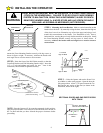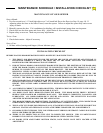
16
E: ADJUSTMENTS
Adjustment #1: Opening Travel
Your opener is assembled at the factory with the trolley in the forward position with the
open limit stops snapped in place on the chain, set for a standard door.
To confirm final opening travel adjustment, activate the opener to bring the door to the
fully open position. When properly adjusted, center of the open limit stops should come to
rest opposite the load adjusting nut.
NOTE: If the door drifts forward, move the open limit stops toward the
power head unit. If the door does not drift forward it is still advised that you
perform one additional check. Operate manual release on the trolley and
allow the door to seek its natural fully open position, then move the open
limit stops to align trolley to this position. If the door does not open fully at
its natural open position, it indicates a door spring or hardware problem that
should be referred to a door system professional.
(See instruction label on side of track for proper limit stop location.)
Adjustment #2: Opening and Closing Force
Hex nuts for adjusting force are located on either side of the rail at the motor end. The left
hex nut, labeled “CLOSE”, adjusts the closing force; the right hex nut, labeled “OPEN”, adjusts the opening force.
Turning the hex nuts clockwise increases force; counterclockwise decreases force.
Your garage door opener is built with a safety system that allows the door to reverse in
the close direction and stop in the open direction. This must be adjusted so your
opener does not use excessive force in the down direction or react to the weight of the
door during upward travel.
To help determine that the force is not excessive, grasp the door handle or bottom edge
during downward travel. The opener should reverse to this force. Do not stand under
the door during this test.
If the handle is hard to hold and the door does not reverse, adjust the CLOSE hex nut
to decrease force until the door reacts properly.
Repeat the adjustment procedure for upward travel. The door should stop without using excessive force.
Adjustment #3: Obstruction Sensing at Close Limit Position
Your opener is designed to automatically reverse the door during closing travel whenever it
comes into contact with an object up to the last 1 inch of travel above the floor. An object on
the floor with a height of less than 1 inch will cause the door to stop. (Test according to the
instructions in Installation Step 19.)
If the opener reverses properly with a 2” x 4” laid flat on the garage floor (Installation Step
19) and stops in the fully closed position, proceed to Adjustment #4.
If the door reverses when it comes into contact with the floor, move the close limit stop,
located on the left side (inside looking out, see figure Adjustment #1), towards the power
head unit. It is advised that you move the close limit stop one link at a time and run opener
through another close cycle, until the door stops when it comes into contact with the floor.
DO NOT USE ADJUSTMENTS TO COMPENSATE FOR A POORLY WORKING DOOR. THIS WILL
INTERFERE WITH THE PROPER OPERATION OF THE REVERSING MECHANISM AND MAY
DAMAGE THE DOOR.
IF LIMITS ARE NOT ADJUSTED
PROPERLY, THE EMERGENCY
RELEASE MECHANISM MAY
NOT WORK PROPERLY AND
DOOR OPERATION COULD
RESULT IN DOOR DAMAGE,
SERIOUS PERSONAL INJURY
OR DEATH!
WARNING
Open Adjustment Nut
Close Adjustment Nut
Leave One Link Open Between
the Two Open Limit Stops
Limit Stops
Chain
Load Adjusting Nut
Limit Stops
110056-2
110056-1


















